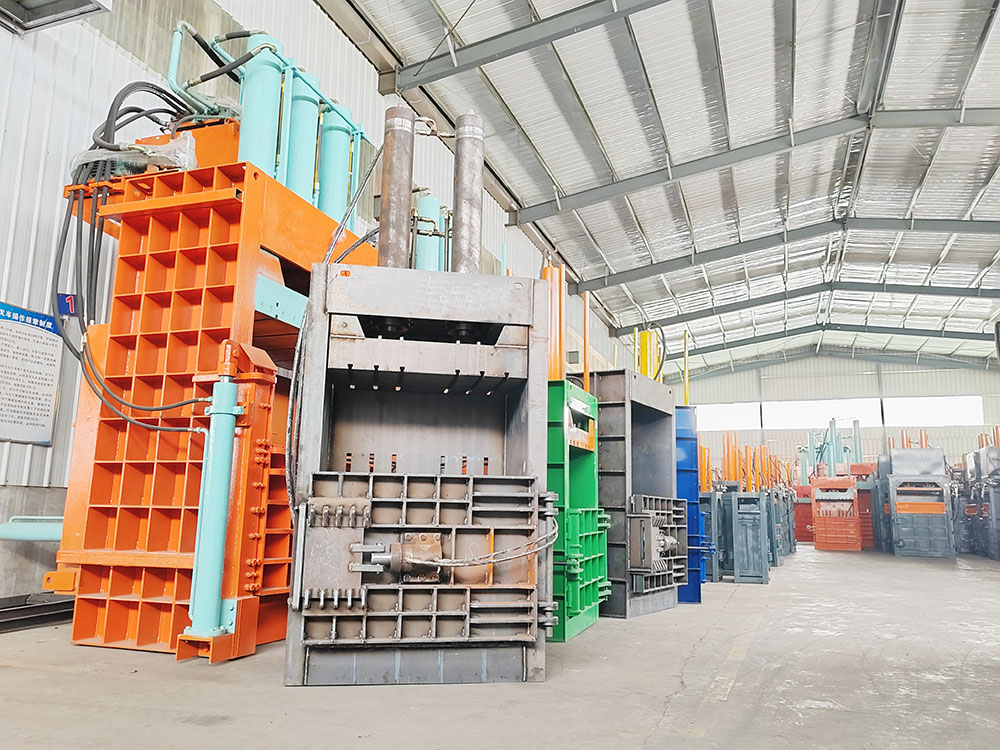Feeling overwhelmed by waste disposal costs? Uncontrolled cardboard and plastic waste eats profits daily. Our precision balers create revenue streams—transforming trash into cash seamlessly.
Recycling baler pricing ranges from $3,000-$50,000+ depending on type/automation, with high-end horizontal models delivering superior long-term ROI through waste-to-revenue conversion and operational savings—turning disposal centers into profit hubs.

Stop guessing payback periods. The real numbers will transform your view of recycling—let’s explore exactly how.
What is a recycling baler?
Waste piles consuming valuable floor space? These industrial workhorses compress loose materials into brick-like bales. Unlike compactors, balers create sellable commodities instantly.
A recycling baler compresses cardboard/plastic waste into dense transportable blocks using hydraulic pressure, optimizing storage efficiency while converting waste costs into resale revenue—key for modern waste-to-profit strategies.
Your Waste Monetization Engine
Modern balers are profit generators disguised as compactors. At ShunYin Machinery, we engineer them with smart features that directly boost bottom lines:
| Feature | Economic Impact | ShunYin Model Advantage |
|---|---|---|
| Bale Density | +30% material value | Dual-piston compression |
| Auto-Strapping | 60% labor reduction | Robotic tie systems |
| Data Logging | Verified ESG reporting | Cloud-connected IoT |
Consider plastic films: Unbaled loads occupy 10㎡. Post-compaction? Just 0.8㎡—freeing warehouse space for revenue activities. One Singaporean distributor gained $15,000/month extra storage capacity this way.
But true value emerges in resale. Our SY-220H creates 550kg PET bales fetching $160+/ton from recyclers—often paying off machines in 14 months.
Ready for waste monetization? Send us volume data: WhatsApp us direct—we’ll calculate your profit potential.
What is the lifespan of a baler machine?
Replacing machines every 5 years? Quality hydraulic balers avoid this drain. Proper maintenance extends service life dramatically—like our Canadian user running units since 2015.
Industrial balers last 8-15 years; lifespan depends on usage/maintenance frequency, with premium models featuring reinforced cylinders and automated lubrication extending durability by 30-40% versus economy units.

Life Extension Economics
Maximizing baler lifespan isn’t luck—it’s engineering. Here’s the maintenance-to-value equation:
Critical Maintenance Components
- Hydraulic Seals: Replace every 3,000 operating hours
- Electrical Systems: Quarterly diagnostic checks
- Compression Plates: Annual alignment verification
ShunYin’s predictive maintenance sensors monitor:
- Oil temperature/purity
- Cylinder pressure consistency
- Motor vibration patterns
| Maintenance Tier | Cost/Year | Lifespan Impact |
|---|---|---|
| Reactive fixes | $2,500 | 5-7 years |
| Scheduled care | $1,200 | 8-10 years |
| Smart monitoring | $800 | 12-15+ years |
North American facilities save $40,000+/machine avoiding premature replacements. For Japanese clients, we supply modular components—swapping parts not whole systems during upgrades.
Curious about your maintenance roadmap? Share machine hours: WhatsApp us direct—we’ll draft your 10-year plan.
How efficient are baler machines?
Hauling air in trucks? Modern balers eliminate wasted transport space. One SY-340H unit at a Tokyo facility reduced weekly shipments from 28 to 4—slashing diesel costs 83%.
Balers deliver efficiency through density: compressing materials to 1/8 original volume while automating processes cuts labor/time costs 40-70%, with smart horizontal models processing 3-5 tons/hour continuously.
Measuring Real-World Efficiency
True efficiency combines throughput with resource savings:
Performance Matrix
| Efficiency Factor | Impact | Data Example |
|---|---|---|
| Material Density | 500kg vs 150kg loose equivalents | 70% transport reduction |
| Operational Speed | 20 bales/hour vs manual 4 | 80% labor decrease |
| Energy Consumption | 22kWh/ton vs industry 32kWh | $9,000/year electricity cut |
Smart variables enhance gains:
- Auto-Eject Systems: Eliminate 7-minute manual bale removal
- Variable Hydraulics: Adapt pressure to material type
- IoT Connectivity: Optimize compression cycles in real-time
A Seattle wholesaler cut $48,000/year staffing costs after switching to our semi-auto line. Our SY-450H models process mixed plastic-cardboard streams at 4.2 tons/hour while self-diagnosing jams.
Need efficiency validation? Film your workflow: WhatsApp us direct—we’ll benchmark improvements.
How heavy is a cardboard baler?
Building floor sinking under equipment? Weight directly indicates durability. Our heaviest horizontal models use 22-ton frames—supporting 60+ tons daily compression safely.
Cardboard balers weigh from 500kg (vertical) to 20,000kg (heavy-duty horizontal); weight signifies structural integrity—crucial for high-throughput operations where lightweight units fail within months.

Weight Versus Strength Optimization
Finding the mass-sweet spot prevents costly reinforcements:
Weight Classification Guide
| Type | Typical Weight | Ideal Floor Loading | Throughput Capacity |
|---|---|---|---|
| Vertical Baler | 0.5-1.5 tons | 1,000 kg/m² | ≤600kg/hour |
| Light Horizontal | 3-7 tons | 2,500 kg/m² | 1-2 tons/hour |
| Industrial Grade | 8-15 tons | 4,800 kg/m² | 3-5 tons/hour |
| Heavy-Duty | 16-22+ tons | 7,200 kg/m² | 6-10+ tons/hour |
Mass distribution matters—our SY-780 uses:
- Box-section steel frames
- Low-center-of-gravity design
- Vibration-dampening mounts
Avoid retrofits: A Canadian recycler paid $28,000 reinforcing floors after buying undersupported balers. We pre-calculate load diagrams using your slab specs for zero surprises.
Concerned about structural needs? Snap your installation space: WhatsApp us direct—we guarantee fit.
Conclusion
Strategic baler investments transform waste costs into measurable profits—optimize yours within one production cycle.








